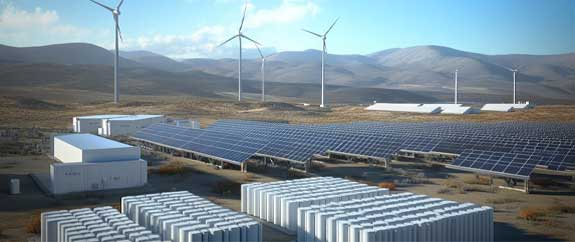1. Nickel’s Role in Battery Technology
One of the most significant contributions of nickel to renewable energy is its use in battery technology, particularly in energy storage solutions for electric vehicles (EVs) and renewable power systems. Nickel is a key component in lithium-ion batteries, specifically in the cathode materials of high-energy density batteries such as Nickel-Cobalt-Aluminum (NCA) and Nickel-Manganese-Cobalt (NMC). These battery chemistries offer several advantages, including higher energy density, longer life cycles, and greater stability, making them ideal for EVs and grid energy storage.
The importance of nickel in batteries lies in its ability to enhance energy density, which allows for more energy storage per unit of mass. This is crucial for EVs, as it directly translates into longer driving ranges and better performance. For grid storage, high-energy density batteries enable more efficient storage of renewable energy from intermittent sources like solar and wind, thereby facilitating a reliable and stable power supply. As the demand for EVs and renewable energy storage continues to grow, the role of nickel in these applications will become even more critical.
2. Nickel in Wind Turbines and Renewable Energy Infrastructure
Nickel is also used extensively in the production of wind turbines, which are a cornerstone of the global renewable energy infrastructure. Stainless steel, which contains nickel, is commonly used in the construction of wind turbine components, including the nacelles, towers, and various internal parts. Nickel's presence in stainless steel enhances the material's corrosion resistance, strength, and durability, which are essential for withstanding the harsh environmental conditions that wind turbines often face, such as saltwater exposure in offshore installations.
Furthermore, nickel alloys are used in the manufacturing of other renewable energy technologies, including geothermal plants and hydroelectric systems. In these applications, nickel contributes to the longevity and reliability of equipment, reducing maintenance costs and enhancing overall efficiency. This, in turn, supports the scalability and economic viability of renewable energy projects, making them more attractive investments in the long term.
3. The Nickel Mining Process and Its Evolution
Nickel mining involves extracting nickel ores, such as laterite and sulfide ores, from the earth and refining them to produce nickel metal. The mining process varies depending on the type of ore, but typically includes steps such as extraction, crushing, grinding, and flotation to separate nickel from other minerals. The refined nickel is then used in the production of alloys, stainless steel, and battery materials.
Traditionally, nickel mining and processing have faced environmental challenges, including high energy consumption, greenhouse gas emissions, and the generation of waste products. However, the industry is evolving, driven by the increasing demand for sustainably sourced nickel in renewable energy applications. To address environmental concerns, mining companies are investing in cleaner technologies and practices, such as the use of renewable energy in mining operations, water recycling, and more efficient ore processing techniques.
One notable advancement is the development of High-Pressure Acid Leaching (HPAL) for laterite ores, which allows for more efficient extraction of nickel with reduced environmental impact. Additionally, efforts are being made to improve the recycling of nickel from end-of-life products, such as spent batteries and stainless steel, further supporting a circular economy and reducing the need for primary mining.
4. Nickel Mining and the Renewable Energy Supply Chain
Nickel mining is a critical link in the renewable energy supply chain, providing the raw material needed for the production of batteries and other key components of clean energy technologies. As the world transitions to a low-carbon economy, the demand for nickel is projected to increase significantly. According to industry forecasts, the global demand for nickel in batteries alone could surge by several times over the next decade, driven by the widespread adoption of EVs and large-scale energy storage solutions.
To meet this growing demand, the nickel mining industry must not only increase production but also ensure that the nickel is produced in an environmentally and socially responsible manner. This includes minimizing the carbon footprint of mining operations, ensuring responsible waste management, and engaging with local communities to support sustainable development. By adopting best practices and innovations, the nickel industry can contribute to a more resilient and sustainable renewable energy supply chain.
5. Challenges and Future Outlook
While nickel mining plays a vital role in supporting renewable energy, it also faces challenges that need to be addressed. These include the environmental impacts of mining, the need for technological advancements to improve extraction efficiency, and the importance of securing a stable supply of high-grade nickel ores. Moreover, geopolitical factors and market volatility can affect the availability and price of nickel, posing risks to the supply chain for renewable energy technologies.
Looking forward, the continued investment in sustainable mining practices, advancements in battery technology, and the development of alternative nickel sources, such as deep-sea mining and recycling, will be crucial in meeting the rising demand for nickel. As the renewable energy sector expands, nickel will remain a cornerstone of the industry, driving innovations that enable a cleaner, greener, and more sustainable world.
Mining of nickel is an essential enabler of renewable energy, providing the raw materials needed to power the transition to a low-carbon future. Through ongoing advancements in mining technology and sustainable practices, nickel will continue to support the growth of clean energy technologies, making it a key player in the global fight against climate change.





